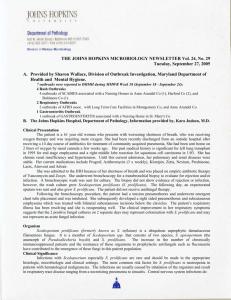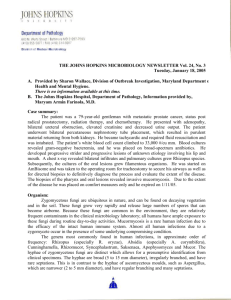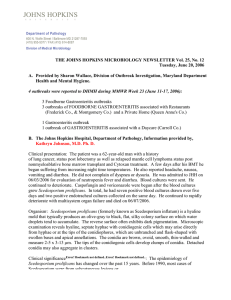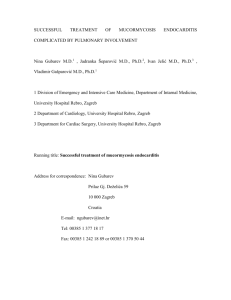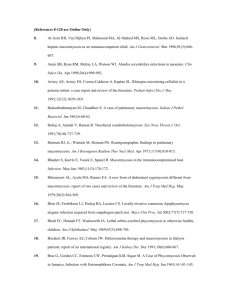Management of Rare Fungal Infections
advertisement
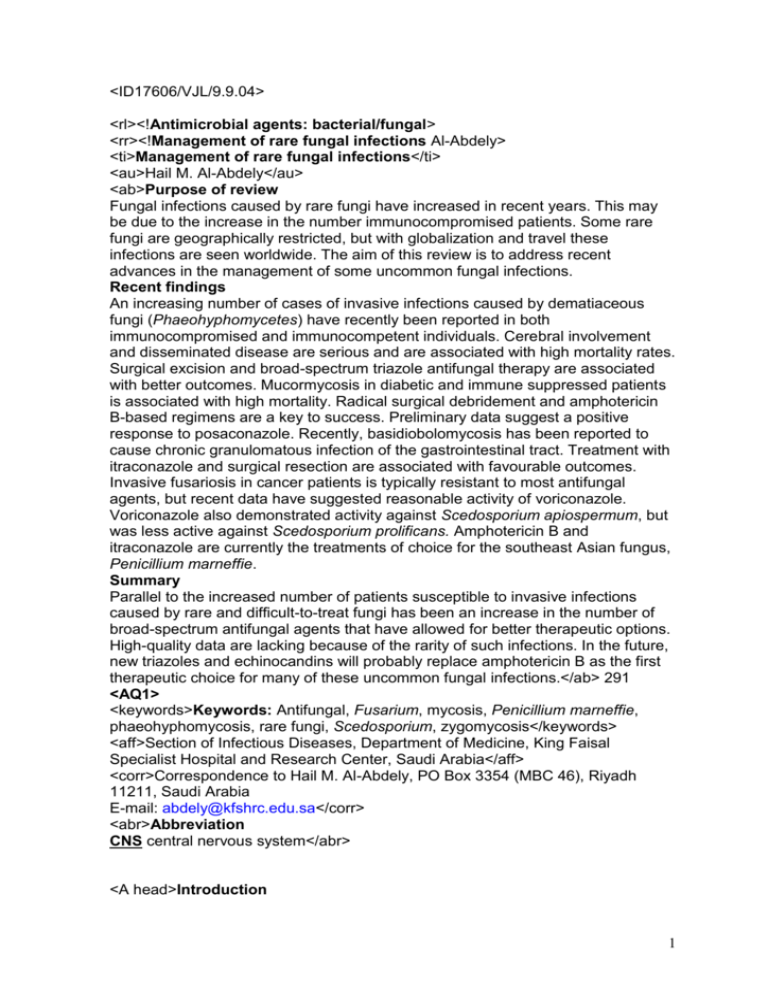
<ID17606/VJL/9.9.04> <rl><!Antimicrobial agents: bacterial/fungal> <rr><!Management of rare fungal infections Al-Abdely> <ti>Management of rare fungal infections</ti> <au>Hail M. Al-Abdely</au> <ab>Purpose of review Fungal infections caused by rare fungi have increased in recent years. This may be due to the increase in the number immunocompromised patients. Some rare fungi are geographically restricted, but with globalization and travel these infections are seen worldwide. The aim of this review is to address recent advances in the management of some uncommon fungal infections. Recent findings An increasing number of cases of invasive infections caused by dematiaceous fungi (Phaeohyphomycetes) have recently been reported in both immunocompromised and immunocompetent individuals. Cerebral involvement and disseminated disease are serious and are associated with high mortality rates. Surgical excision and broad-spectrum triazole antifungal therapy are associated with better outcomes. Mucormycosis in diabetic and immune suppressed patients is associated with high mortality. Radical surgical debridement and amphotericin B-based regimens are a key to success. Preliminary data suggest a positive response to posaconazole. Recently, basidiobolomycosis has been reported to cause chronic granulomatous infection of the gastrointestinal tract. Treatment with itraconazole and surgical resection are associated with favourable outcomes. Invasive fusariosis in cancer patients is typically resistant to most antifungal agents, but recent data have suggested reasonable activity of voriconazole. Voriconazole also demonstrated activity against Scedosporium apiospermum, but was less active against Scedosporium prolificans. Amphotericin B and itraconazole are currently the treatments of choice for the southeast Asian fungus, Penicillium marneffie. Summary Parallel to the increased number of patients susceptible to invasive infections caused by rare and difficult-to-treat fungi has been an increase in the number of broad-spectrum antifungal agents that have allowed for better therapeutic options. High-quality data are lacking because of the rarity of such infections. In the future, new triazoles and echinocandins will probably replace amphotericin B as the first therapeutic choice for many of these uncommon fungal infections.</ab> 291 <AQ1> <keywords>Keywords: Antifungal, Fusarium, mycosis, Penicillium marneffie, phaeohyphomycosis, rare fungi, Scedosporium, zygomycosis</keywords> <aff>Section of Infectious Diseases, Department of Medicine, King Faisal Specialist Hospital and Research Center, Saudi Arabia</aff> <corr>Correspondence to Hail M. Al-Abdely, PO Box 3354 (MBC 46), Riyadh 11211, Saudi Arabia E-mail: abdely@kfshrc.edu.sa</corr> <abr>Abbreviation CNS central nervous system</abr> <A head>Introduction 1 <txt>Most invasive fungal infections are opportunistic and take advantage of the host’s immune system defects. Fungi are widely distributed in nature, but several pathogenic fungi are restricted to some extent by geography, such as endemic mycoses in the new world, especially coccidioidomycosis and Penicillium marneffie in southeast Asia. More reports of fungi that were not previously known to cause human disease are reported every year, and some of the rarely encountered fungal infections are becoming more common [1*]. Many of these rarely seen fungal infections are serious and can be life threatening. Data on the management of such rare and serious infections are of low quality because of their rarity. Therefore, we have to utilize what is available to us, such as anecdotal reports, case series, animal studies or even in-vitro susceptibility tests. This review will address the management of some, and not most, of the less commonly recognized serious fungal infections. <A head>Phaeohyphomycosis <txt>Dematiaceous fungi (Phaeohyphomycetes) are the cause of wide spectrum of infections that range from limited cutaneous to disseminated disease [2*]. Infections caused by these darkly pigmented fungi are given the name phaeohyphomycosis. Several species of Phaeohyphomycetes are neurotropic, and have been reported to cause mainly primary central nervous system (CNS) infections [3**,4*]. Disseminated and CNS infections caused by these fungi are associated with high mortality rates that exceed 70% [3**,5]. Cladophialophora bantiana is the most common fungus reported to cause primary cerebral phaeohyphomycosis [3**]. Ramichloridium mackenziei has been reported to cause brain abscesses exclusively. Although C. bantiana has been reported worldwide, R. mackenziei has been restricted to the middle-east and in particular the Gulf region [6--9]. Cerebral infection as a result of such fungi has struck both immunocompetent and immunocompromised individuals with similar dismal outcomes. Disseminated disease caused by Phaeohyphomycetes is rare and has affected mainly immunocompromised patients. A large number of species has been reported to cause disseminated disease, with Bipolaris spicefera and Wangiella (Exophiala) dermatitidis being the most common. Treatment for cerebral infection is difficult as these fungi are commonly resistant to antifungal agents, and its localization in the brain affects the concentration of the antifungal agent at the site of infection. Surgical debulking is useful for solitary lesions, but is difficult to attain for multiple lesions. Surgical options for disseminated disease are limited. Amphotericin B was inferior to azoles against many of the Phaeohyphomycetes in vitro, in animal models and in several reported cases [3**,10--12]. Liposomal amphotericin B has better CNS concentrations than amphotericin B deoxycholate, and is safe at high doses that may make it favourable in the treatment of cerebral phaeohyphomycosis. Better survival was seen in the few cases of cerebral phaeohyphomycosis that were treated with liposomal amphotericin B [13--15]. 5Flucytosine has activity against many of these fungi and could be a useful agent when combined with other antifungal drugs. Broad-spectrum azoles such as itraconazole have been used in the treatment of phaeohyphomycosis with variable results [16]. Limited disease with cutaneous involvement or sinusitis had the best response, whereas disseminated disease and cerebral involvement was associated with more failures [17--19]. Voriconazole was unsuccessful in the treatment of a brain abscess caused by C. bantiana, even when combined with caspofungin in another case [20*,21*]. Voriconazole was used in one patient with disseminated infection caused by Ochroconis gallopavum with a positive response 2 [22*]. Posaconazole was successful in animal models of Ramichloridium and Cladophialophora experimental cerebral infections [10,23]. It was also used in the treatment of a few cases of phaeohyphomycosis, including a recent case of R. mackenziei brain abscess [24*]. Terbinafine was successful in the treatment of refractory subcutaneous infection caused by Exophiala jeanselmei, which may suggest a possible future rule of this agent in the treatment of phaeohyphomycosis in combination with other antifungal agents [25,26]. No clinical data are yet available on the rule of echinocandins against infections caused by Phaehyphomycetes, but one in-vitro study has shown activity of anidulafungin against several dematiaceous fungi [27]. <A head>Zygomycosis <AQ2> <B head>Mucormycosis <txt>Mucormycosis is an aggressive fungal infection caused by the order Mucorales of the class Zygomycetes. Most of the cases of mucormycosis are caused by Rhizopus species, but other Mucorales are also well known to cause the same clinical disease. These fungi are rapidly growing and angioinvasive, which leads to rapidly progressive tissue necrosis. Diabetic patients, especially with acidosis, are typically susceptible. Immunocompromised patients on immunosuppressive agents or with neutropenia are susceptible to this infection, which can be disseminated [28]. Iron chelating therapy with deferroxamine is a well-recognized risk factor especially in renal failure patients. Occasionally, cases of cutaneous disease can develop from breaks in the skin after trauma. Most cases involve the nasal mucosa and sinuses, with rapid spread to the orbit and the brain. Other organs can be involved, including the lung, gastrointestinal organs, or can disseminate to involve multiple sites. Mortality is in the range of 70% for rhinocerebral disease, and approaches 100% for disseminated disease [29]. Cutaneous infection has the best outcome, with a mortality rate of approximately 15%. The cornerstone in the management of mucormycosis is radical surgical debridement of devitalized tissue [30,31]. The timing of surgery is important because this is a rapidly progressive infection, and therefore requires urgent surgery. Adjunctive antifungal therapy is essential, and should be initiated immediately. Amphotericin B in high doses of 1--1.5 mg/kg a day is the only currently available agent with activity against the Mucorales. The duration of amphotericin B therapy needs to be adjusted according to the disease extent, patient progression and toxicity. The typical cumulative dose required ranges from 2 to 4 g. Lipid formulations of amphotericin B have been reported to be successful in many cases of mucormycosis [32--34]. They could be the initial therapy for patients with this infection, because most of them will not tolerate high doses of amphotericin B deoxycholate. Recent reports indicate good activity of the investigational triazole posaconazole against mucormycosis. An animal model of mucormycosis in mice treated with posaconazole suggested efficacy against this infection [35,36]. A case report [37*] then a series of 23 cases treated with this agent [38*] have indicated comparable outcomes to historical cases of mucormycosis treated with amphotericin B. Other azoles and echinocandins have not shown significant in-vitro activity against the Mucorales. In one report [39] micafungin was associated with the resolution of probable sinus mucormycosis in an autologous bone marrow transplant recipient. <B head>Entomophthoramycosis 3 <txt>Entomophthorales are Zygomycetes that consist mainly of the Basidiobolus and Conoidiobolus species. Basidiobolomycosis is a fungal infection that has been reported mainly in tropical and subtropical regions [40*]. It is caused by Basidiobolus ranarum. Most reports have described the infection as mainly involving subcutaneous tissue [41]. Several reports have recently described invasive visceral infection involving mainly the gastrointestinal tract, especially the colon in immunocompetent individuals [42*,43]. Such reports have come from Arizona, Brazil, Kuwait, Saudi Arabia and other countries. In the report from Saudi Arabia of six cases, all patients were in the paediatric age group and were clustered in one subtropical region in the southwest of the country. Cases reported from Arizona were adults. No particular risk factors could be identified. The infection is characterized by a chronic granulomatous inflammation and eosinophilic infiltration, which results in large abdominal masses [44]. These infections are initially misdiagnosed as cancer, tuberculosis or Crohn’s disease. Successful treatment has been reported mainly with surgical resection and triazole treatment, with itraconazole and ketoconazole. Mortality was significant and was attributed to gastrointestinal haemorrhage. Conidiobolomycosis, caused by C. coronatus and C. incongruous, has been reported to affect mainly the face and ear, nose and throat organs. It causes subcutaneous and submucosal disease [40*]. The infection is indolent and is characterized by enlarging masses. Histopathologically, this infection does not differ from Basidiobolomycosis. Surgical excision and antifungal treatment with itraconazole is reasonable. Different antimicrobial agents have been tried for the treatment of conidiobolomycosis with variable responses. These include trimethoprim/sulfamethoxazole, terbinafine, potassium iodide and amphotericin B [45--47]. <A head>Fusariosis <txt>Fusarium species are the cause of a wide variety of fungal infections, which range from keratitis, onychomycosis, eumycetoma in the immunocompent to invasive and disseminated disease in the immunocompromised patient, especially in patients with haematology cancer and neutropenia [48]. Fusariosis is a recognized infection in the pre and post-engraftment of allogeneic bone marrow transplantation. The incidence of invasive fusariosis has increased over time in several cancer centres in the United States [49]. The most common species associated with human infection are Fusarium solani, Fusarium oxysporum and Fusarium moniliforme. Any organ can be affected in disseminated fusariosis, although the skin and lung are the two most commonly involved organs. Skin lesions are variable in number, size and characteristics, and are frequently associated with fusarium fungemia [50*,51]. Fusarium resistance to almost all antifungal agents and the severely depressed host defence mechanisms in haematological malignancies made this infection commonly fatal. The number and function of phagocytes is the most important determinant of outcome. White blood cells growth factors, granulocyte and granulocyte-macrophage colony stimulating factor or granulocyte transfusions should be considered in neutropenic patients. Surgical excision of a solitary cutaneous lesion is indicated to prevent local progression or dissemination. Voriconazole was recently approved for the treatment of fusariosis after in-vitro data and human reports indicated activity against fusariosis [52--54]. Successes have also been reported with amphotericin B and its lipid formulations. Posaconazole showed activity against Fusarium spp. in vitro, in vivo and in one case report [55--57]. Echinocandins have not 4 demonstrated in-vitro activity against Fusarium spp., but there was one report of a response to caspofungin in a patient with leukemia [58]. <A head>Scedosporiosis <AQ3> <B head>Scedosporium apiospermum <txt>Infections caused by Scedosporium apiosprmum (teleomorph; Pseudoallescheria boydii) in the normal host are typically chronic and involve subcutaneous tissue and bone to form eumycetoma [59]. It can occasionally disseminate in victims of near-drowning. Invasive disease is usually observed in the immunocompromised host. Lung infection is the most common, but the sinuses and brain are recognized sites. Occasionally it can disseminate to involve multiple organs. This fungus is commonly amphotericin B resistant, and the drugs of choice are the extended-spectrum azoles such as itraconazole and voriconazole. Voriconazole has United States Food and Drug Administration approval for this infection, and was shown to be successful in a few cases [60-62]. Posaconazole was successful in one case report of cerebral infection [63]. Surgical excision remains a mainstay treatment of this infection whenever feasible; this is especially true for soft tissue and bone involvement. Echinocandins are active in vitro against S. apiospermum but as yet there are no reports on the treatment of this organism in patients. <B head>Scedosporium prolificans <txt>This fungus is considered by some mycologists to be a Phaeohyphomycetes as it is darkly pigmented in culture media. It is a rare cause of human disease, with most cases being reported from Australia and Spain [59]. Neutropenia in patients with haematological malignancies was the most common risk factor associated with disseminated infection. Locally invasive joint and bone disease was mostly associated with trauma in immunocompetent patients. Disseminated disease caused by Scedosporium prolificans is usually fatal [5]. The fungus is universally resistant to all currently available antifungal agents. A few patients with S. prolificans infection have responded to voriconazole [64,65]. Phagocytic function and the extent of disease are the most important prognostic factors. Therefore, granulocyte colony stimulating factor can accelerate neutrophil recovery and the response to antifungal therapy. Terbinafine has shown in-vitro activity against this fungus, and has been shown to be successful in combination with triazoles such as voriconazole [66--68]. Surgical excision is the mainstay treatment for locally invasive disease. <A head>Penicilliosis marneffie <txt>Penicillium marneffie is a fungus geographically restricted to southeast Asia. It is the only known fungus of the Penicillium species to be thermally dimorphic. Since its description 1956 as a cause of infection in bamboo rats (Rhizomys sinensis) in Vietnam, it has been recognized as a human pathogen, with all the cases coming from southeast Asia or individuals who have travelled to that area. In recent years, there has been an enormous increase in the incidence of this infection in endemic areas, largely corresponding with the increase in the number of AIDS cases [69]. Disseminated disease is most commonly associated with advanced HIV infection. 5 The infection is usually associated with prolonged fever, chills and debilitation, with weight loss and anaemia; generalized lymphadenopathy and hepatomegaly are common. Diffuse papular lesions with central umblication resembling moluscum contagiosum lesions are common in HIV patients. If untreated, penicilliosis marneffei is usually fatal. Amphotericin B with or without 5-flucytosine has been successful in treating penicilliosis marneffei infection. Azoles, particularly itraconazole and ketoconazole, have been very active against P. marneffei in vitro and in patients. Fluconazole is the least active of the currently available azoles and is associated with more failures [70]. Treatment options are determined by the clinical status of the patient and the availability and cost of the drugs. For severely sick patients, amphoterecin B (0.5--0.7 mg/kg a day) is the drug of choice. For less sick patients, azole treatment with itraconazole 400 mg/day is indicated. The duration of treatment varies with the immune status of the patient. For HIV-infected patients, long-term suppressive therapy is indicated unless they have immune reconstitution with highly active antiretroviral therapy and an increase in the CD4 cell count to more than 100 cells/ml. Itraconazole was extremely effective in preventing relapse in patients with AIDS [71]. A high response rate of 97% was demonstrated in a non-randomized trial of amphotericin B 0.6 mg/kg a day for 2 weeks, followed by 10 weeks of itraconazole 400 mg a day [72]. Echinocandins have demonstrated some in-vitro activity against P. marneffie, but clinical data are lacking [73]. More recognized rare fungal species are reported every year as a cause of human disease. There is the emergence of several yeast-like fungi such as the Trichosporon species, Blastoschizomyces capitatum and Rhodotorula in immunocompromised patients. Mould infections caused by Paecillomyces spp. and Trichoderma spp. are increasingly being recognized [1*,74*]. <A head>Conclusion <txt>The management of rare fungal infections is obviously difficult. Surgical excision in an anatomically limited disease should always be considered. Fungal culture and the identification of the causative fungus is essential in designing the best approach for management. In-vitro susceptibility testing or animal studies may be the only clue in the choice of the appropriate antifungal agent. Augmentation of the host immune response, whenever feasible, is a critical factor in the better outcome of immune suppressed patients with fungal infections. <refs> 1* Walsh TJ, Groll A, Hiemenz J, et al. Infections due to emerging and uncommon medically important fungal pathogens. Clin Microbiol Infect 2004; 10 (Suppl. 1):48-66. A very good review of many recently emerging pathogenic fungi. It details the microbiological and clinical features as well as therapeutic options. 2* Brandt ME, Warnock DW. Epidemiology, clinical manifestations, and therapy of infections caused by dematiaceous fungi. J Chemother 2003; 15 (Suppl. 2):36--47. A comprehensive review of infections caused by dematiaceous fungi. All clinical entities are included, which range from cutaneous, sinus to cerebral and disseminated disease. 3** Revankar SG, Sutton DA, Rinaldi MG. Primary central nervous system phaeohyphomycosis: a review of 101 cases. Clin Infect Dis 2004; 38:206--216. 6 An excellent review of almost all cases of cerebral phaeohyphomycosis reported in the literature. A total of 101 cases. C. bantiana was the most common (48%) followed by R. mackenziei (13%). It reviews the clinical features, therapy and outcome of these cases. 4* Kantarcioglu AS, de Hoog GS. Infections of the central nervous system by melanized fungi: a review of cases presented between 1999 and 2004. Mycoses 2004; 47:4--13. Another good and comprehensive review of recent cases of cerebral phaeohyphomycosis. 5 Revankar SG, Patterson JE, Sutton DA, et al. Disseminated phaeohyphomycosis: review of an emerging mycosis. Clin Infect Dis 2002; 34:467-476. 6 Khan ZU, Lamdhade SJ, Johny M, et al. Additional case of Ramichloridium mackenziei cerebral phaeohyphomycosis from the Middle East. Med Mycol 2002; 40:429--433. 7 Kanj SS, Amr SS, Roberts GD. Ramichloridium mackenziei brain abscess: report of two cases and review of the literature. Med Mycol 2001; 39:97--102. 8 Podnos YD, Anastasio P, De La Maza L, Kim RB. Cerebral phaeohyphomycosis caused by Ramichloridium obovoideum (Ramichloridium mackenziei): case report. Neurosurgery 1999; 45:372--375. 9 Sutton DA, Slifkin M, Yakulis R, Rinaldi MG. US case report of cerebral phaeohyphomycosis caused by Ramichloridium obovoideum (R. mackenziei): criteria for identification, therapy, and review of other known dematiaceous neurotropic taxa. J Clin Microbiol 1998; 36:708--715. 10 Al-Abdely HM, Najvar L, Bocanegra R, et al. SCH 56592, amphotericin B, or itraconazole therapy of experimental murine cerebral phaeohyphomycosis due to Ramichloridium obovoideum ("Ramichloridium mackenziei"). Antimicrob Agents Chemother 2000; 44:1159--1162. 11 Johnson EM, Szekely A, Warnock DW. In vitro activity of Syn-2869, a novel triazole agent, against emerging and less common mold pathogens. Antimicrob Agents Chemother 1999; 43:1260--1263. 12 Johnson EM, Szekely A, Warnock DW. In-vitro activity of voriconazole, itraconazole and amphotericin B against filamentous fungi. J Antimicrob Chemother 1998; 42:741--745. 13 Singh N, Chang FY, Gayowski T, Marino IR. Infections due to dematiaceous fungi in organ transplant recipients: case report and review. Clin Infect Dis 1997; 24:369--374. 14 Vukmir RB, Kusne S, Linden P, et al. Successful therapy for cerebral phaeohyphomycosis due to Dactylaria gallopava in a liver transplant recipient. Clin Infect Dis 1994; 19:714--719. 15 Al-Mohsen IZ, Sutton DA, Sigler L, et al. Acrophialophora fusispora brain abscess in a child with acute lymphoblastic leukemia: review of cases and taxonomy. J Clin Microbiol 2000; 38:4569--4576. 16 Sharkey PK, Graybill JR, Rinaldi MG, et al. Itraconazole treatment of phaeohyphomycosis. J Am Acad Dermatol 1990; 23:577--586. 17 Halaby T, Boots H, Vermeulen A, et al. Phaeohyphomycosis caused by Alternaria infectoria in a renal transplant recipient. J Clin Microbiol 2001; 39:1952-1955. 18 Keyser A, Schmid FX, Linde HJ, et al. Disseminated Cladophialophora bantiana infection in a heart transplant recipient. J Heart Lung Transplant 2002; 21:503--505. 7 19 Safdar A. Curvularia -- favorable response to oral itraconazole therapy in two patients with locally invasive phaeohyphomycosis. Clin Microbiol Infect 2003; 9:1219--1223. 20* Fica A, Diaz MC, Luppi M, et al. Unsuccessful treatment with voriconazole of a brain abscess due to Cladophialophora bantiana. Scand J Infect Dis 2003; 35:892-893. A case that demonstrates the difficulty in treating cerebral infection caused by C. bantiana even with the broad-spectrum triazole voriconazole. 21* Trinh JV, Steinbach WJ, Schell WA, et al. Cerebral phaeohyphomycosis in an immunodeficient child treated medically with combination antifungal therapy. Med Mycol 2003; 41:339--345. This is a case in which voriconazole and caspofungin were combined for the treatment of C. bantiana. 22* Wang TK, Chiu W, Chim S, et al. Disseminated ochroconis gallopavum infection in a renal transplant recipient: the first reported case and a review of the literature. Clin Nephrol 2003; 60:415--423. A report of a positive response to voriconazole in the treatment of Phaeohyphomycetes. 23 Al-Abdely HM, Najvar L, Bocanegra R, Graybill JR. SCH56592 (SCH) therapy of experimental murine cerebral phaeohyphomycosis due to Cladophialophora bantiana (CB). In: 38th Interscience Conference on Antimicrobial Agents and Chemotherapy. San Diego, CA, 1998 [Abstract no. J-69]. 24* Al-Abdely HM, Alkunaizi A, Al-Tawfiq J, et al. Successful therapy of cerebral phaeohyphomycosis due to Ramichloridium mackenziei with the new triazole posaconazole. In: 13th European Congress of Clinical Microbiology and Infectious Diseases. Glasgow, UK: Clinical Microbiology and Infection, 2003 [Abstract no. P548]. The first case of the prolonged survival of R. mackenziei cerebral infection in a renal transplant recipient. 25 Agger WA, Andes D, Burgess JW. Exophiala jeanselmei infection in a heart transplant recipient successfully treated with oral terbinafine. Clin Infect Dis 2004; 38:e112--e115. 26 Ryder NS. Activity of terbinafine against serious fungal pathogens. Mycoses 1999; 42 (Suppl. 2):115--119. 27 Odabasi Z, Paetznick VL, Rodriguez JR, et al. In vitro activity of anidulafungin against selected clinically important mold isolates. Antimicrob Agents Chemother 2004; 48:1912--1915. 28 Gonzalez CE, Rinaldi MG, Sugar AM. Zygomycosis. Infect Dis Clin North Am 2002; 16:895--914, vi. 29 Adam RD, Hunter G, DiTomasso J, Comerci G Jr. Mucormycosis: emerging prominence of cutaneous infections. Clin Infect Dis 1994; 19:67--76. 30 Parfrey NA. Improved diagnosis and prognosis of mucormycosis. A clinicopathologic study of 33 cases. Medicine (Baltimore) 1986; 65:113--123. 31 Petrikkos G, Skiada A, Sambatakou H, et al. Mucormycosis: ten-year experience at a tertiary-care center in Greece. Eur J Clin Microbiol Infect Dis 2003; 22:753--756. 32 Handzel O, Landau Z, Halperin D. Liposomal amphotericin B treatment for rhinocerebral mucormycosis: how much is enough? Rhinology 2003; 41:184--186. 33 Mondy KE, Haughey B, Custer PL, et al. Rhinocerebral mucormycosis in the era of lipid-based amphotericin B: case report and literature review. Pharmacotherapy 2002; 22:519--526. 8 34 Herbrecht R, Letscher-Bru V, Bowden RA, et al. Treatment of 21 cases of invasive mucormycosis with amphotericin B colloidal dispersion. Eur J Clin Microbiol Infect Dis 2001; 20:460--466. 35 Dannaoui E, Meis JF, Loebenberg D, Verweij PE. Activity of posaconazole in treatment of experimental disseminated zygomycosis. Antimicrob Agents Chemother 2003; 47:3647--3650. 36 Sun QN, Najvar LK, Bocanegra R, et al. In vivo activity of posaconazole against Mucor spp. in an immunosuppressed-mouse model. Antimicrob Agents Chemother 2002; 46:2310--2312. 37* Tobon AM, Arango M, Fernandez D, Restrepo A. Mucormycosis (zygomycosis) in a heart--kidney transplant recipient: recovery after posaconazole therapy. Clin Infect Dis 2003; 36:1488--1491. A case of mucormycosis that responded to the oral triazole posaconazole. 38* Greenberg R, Herbrecht R, Langston A, et al. Posaconazole therapy of refractory invasive zygomycosis. In: 43rd Interscience Conference on Antimicrobial Agents and Chemotherapy. Chicago, IL; 2003 [Abstract M-1757]. A case series that demonstrated the efficacy of posaconazole in the treatment of refractory mucormycosis. 39 Jacobs P, Wood L, Du Toit A, Esterhuizen K. Eradication of invasive mucormycosis -- effectiveness of the Echinocandin FK463. Hematology 2003; 8:119--123. 40* Prabhu RM, Patel R. Mucormycosis and entomophthoramycosis: a review of the clinical manifestations, diagnosis and treatment. Clin Microbiol Infect 2004; 10 (Suppl. 1):31--47. A comprehensive review of the microbiology and clinical data on zygomycosis that includes entomophthoramycosis. 41 Gugnani HC. A review of zygomycosis due to Basidiobolus ranarum. Eur J Epidemiol 1999; 15:923--929. 42* Al Jarie A, Al-Mohsen I, Al Jumaah S, et al. Pediatric gastrointestinal basidiobolomycosis. Pediatr Infect Dis J 2003; 22:1007--1014. A detailed description of six cases of basidiobolomycosis of the gastrointestinal tract from Saudi Arabia. 43 Lyon GM, Smilack JD, Komatsu KK, et al. Gastrointestinal basidiobolomycosis in Arizona: clinical and epidemiological characteristics and review of the literature. Clin Infect Dis 2001; 32:1448--1455. 44 Yousef OM, Smilack JD, Kerr DM, et al. Gastrointestinal basidiobolomycosis. Morphologic findings in a cluster of six cases. Am J Clin Pathol 1999; 112:610-616. 45 al-Hajjar S, Perfect J, Hashem F, et al. Orbitofascial conidiobolomycosis in a child. Pediatr Infect Dis J 1996; 15:1130--1132. 46 Krishnan SG, Sentamilselvi G, Kamalam A, et al. Entomophthoromycosis in India -- a 4-year study. Mycoses 1998; 41:55--58. 47 Foss NT, Rocha MR, Lima VT, et al. Entomophthoramycosis: therapeutic success by using amphotericin B and terbinafine. Dermatology 1996; 193:258-260. 48 Dignani MC, Anaissie E. Human fusariosis. Clin Microbiol Infect 2004; 10 (Suppl. 1):67--75. 49 Nucci M, Marr KA, Queiroz-Telles F, et al. Fusarium infection in hematopoietic stem cell transplant recipients. Clin Infect Dis 2004; 38:1237--1242. 50* Jensen TG, Gahrn-Hansen B, Arendrup M, Bruun B. Fusarium fungaemia in immunocompromised patients. Clin Microbiol Infect 2004; 10:499--501. 9 A nice review of Fusarium fungemia, with associated features, therapy and outcomes. 51 Nucci M, Anaissie E. Cutaneous infection by Fusarium species in healthy and immunocompromised hosts: implications for diagnosis and management. Clin Infect Dis 2002; 35:909--920. 52 Consigny S, Dhedin N, Datry A, et al. Successsful voriconazole treatment of disseminated fusarium infection in an immunocompromised patient. Clin Infect Dis 2003; 37:311--313. 53 Guimera-Martin-Neda F, Garcia-Bustinduy M, Noda-Cabrera A, et al. Cutaneous infection by Fusarium: successful treatment with oral voriconazole. Br J Dermatol 2004; 150:777--778. 54 Vincent AL, Cabrero JE, Greene JN, Sandin RL. Successful voriconazole therapy of disseminated Fusarium solani in the brain of a neutropenic cancer patient. Cancer Control 2003; 10:414--419. 55 Paphitou NI, Ostrosky-Zeichner L, Paetznick VL, et al. In vitro activities of investigational triazoles against Fusarium species: effects of inoculum size and incubation time on broth microdilution susceptibility test results. Antimicrob Agents Chemother 2002; 46:3298--3300. 56 Lozano-Chiu M, Arikan S, Paetznick VL, et al. Treatment of murine fusariosis with SCH 56592. Antimicrob Agents Chemother 1999; 43:589--591. 57 Sponsel WE, Graybill JR, Nevarez HL, Dang D. Ocular and systemic posaconazole (SCH-56592) treatment of invasive Fusarium solani keratitis and endophthalmitis. Br J Ophthalmol 2002; 86:829--830. 58 Apostolidis J, Bouzani M, Platsouka E, et al. Resolution of fungemia due to Fusarium species in a patient with acute leukemia treated with caspofungin. Clin Infect Dis 2003; 36:1349--1350. 59 Steinbach WJ, Perfect JR. Scedosporium species infections and treatments. J Chemother 2003; 15 (Suppl. 2):16--27. 60 Danaher PJ, Walter EA. Successful treatment of chronic meningitis caused by Scedosporium apiospermum with oral voriconazole. Mayo Clin Proc 2004; 79:707-708. 61 Klopfenstein KJ, Rosselet R, Termuhlen A, Powell D. Successful treatment of Scedosporium pneumonia with voriconazole during AML therapy and bone marrow transplantation. Med Pediatr Oncol 2003; 41:494--495. 62 Bosma F, Voss A, van Hamersvelt HW, et al. Two cases of subcutaneous Scedosporium apiospermum infection treated with voriconazole. Clin Microbiol Infect 2003; 9:750--753. 63 Mellinghoff IK, Winston DJ, Mukwaya G, Schiller GJ. Treatment of Scedosporium apiospermum brain abscesses with posaconazole. Clin Infect Dis 2002; 34:1648--1650. 64 Studahl M, Backteman T, Stalhammar F, et al. Bone and joint infection after traumatic implantation of Scedosporium prolificans treated with voriconazole and surgery. Acta Paediatr 2003; 92:980--982. 65 Steinbach WJ, Schell WA, Miller JL, Perfect JR. Scedosporium prolificans osteomyelitis in an immunocompetent child treated with voriconazole and caspofungin, as well as locally applied polyhexamethylene biguanide. J Clin Microbiol 2003; 41:3981--3985. 66 Howden BP, Slavin MA, Schwarer AP, Mijch AM. Successful control of disseminated Scedosporium prolificans infection with a combination of voriconazole and terbinafine. Eur J Clin Microbiol Infect Dis 2003; 22:111--113. 10 67 Gosbell IB, Toumasatos V, Yong J, et al. Cure of orthopaedic infection with Scedosporium prolificans, using voriconazole plus terbinafine, without the need for radical surgery. Mycoses 2003; 46:233--236. 68 Meletiadis J, Mouton JW, Meis JF, Verweij PE. In vitro drug interaction modeling of combinations of azoles with terbinafine against clinical Scedosporium prolificans isolates. Antimicrob Agents Chemother 2003; 47:106--117. 69 Al-Abdely HM, Graybill JR. Penicilliosis marneffie. In: Guerrant R, Walker D, Weller P, editors. Tropical infectious diseases, principles, pathogens and practice. <AQ4> Churchill Livingstone; 1999. pp. 641--644. 70 Supparatpinyo K, Nelson KE, Merz WG, et al. Response to antifungal therapy by human immunodeficiency virus-infected patients with disseminated Penicillium marneffei infections and in vitro susceptibilities of isolates from clinical specimens. Antimicrob Agents Chemother 1993; 37:2407--2411. 71 Supparatpinyo K, Perriens J, Nelson KE, Sirisanthana T. A controlled trial of itraconazole to prevent relapse of Penicillium marneffei infection in patients infected with the human immunodeficiency virus. N Engl J Med 1998; 339:1739-1743. 72 Sirisanthana T, Supparatpinyo K, Perriens J, Nelson KE. Amphotericin B and itraconazole for treatment of disseminated Penicillium marneffei infection in human immunodeficiency virus-infected patients. Clin Infect Dis 1998; 26:1107--1110. 73 Nakai T, Uno J, Ikeda F, et al. In vitro antifungal activity of Micafungin (FK463) against dimorphic fungi: comparison of yeast-like and mycelial forms. Antimicrob Agents Chemother 2003; 47:1376--1381. 74* Bouza E, Munoz P. Invasive infections caused by Blastoschizomyces capitatus and Scedosporium spp. Clin Microbiol Infect 2004; 10 (Suppl. 1):76--85. A nice review of some of the less commonly encountered fungi. QUERIES TO AUTHOR No. Query 1 The abstract must be no more than 250 words in length, therefore could you please cut it from the present 291 words, without removing definite articles and using abbreviations, which are not allowed in the abstract 2 Please insert an introductory sentence or paragraph here to separate headings 3 Please insert an introductory sentence or paragraph here to separate headings 4 Ref 69 -- please provide location of publisher Churchill Livingstone 11
